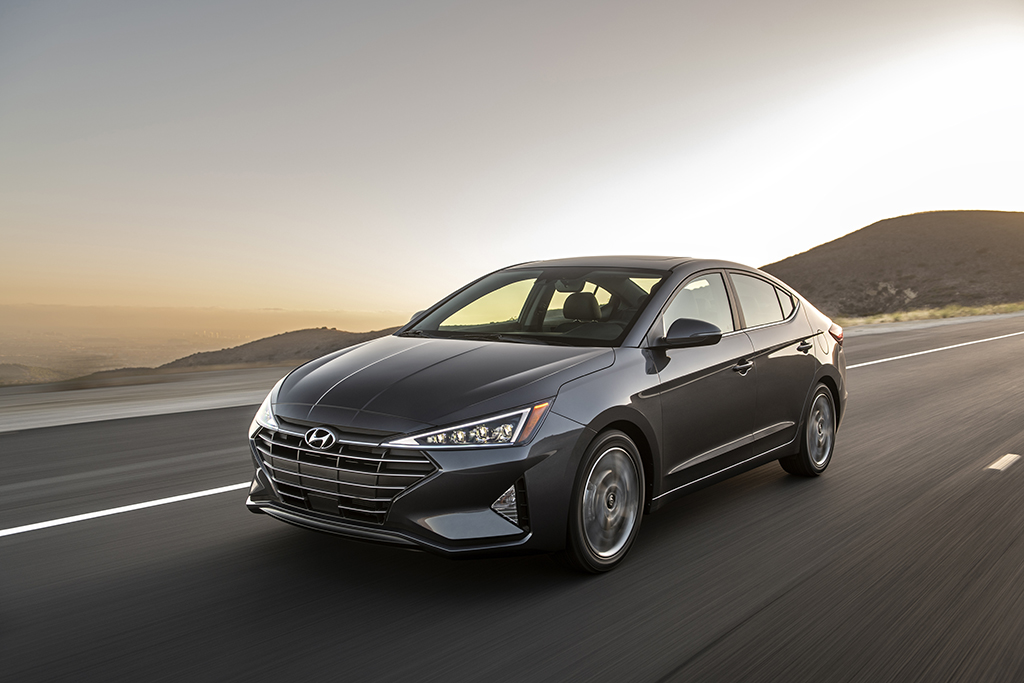Editor’s note: This Car Seat Check was written in March 2019 about the 2019 Hyundai Elantra. Little of substance has changed with this year’s model. See what’s new for 2020 or check out a side-by-side comparison of the two model years.
The verdict: For smaller families, a compact car can deliver the right blend of value and room, and the Hyundai Elantra fits that equation. The compact sedan was revised for 2019 with fresh styling, an updated multimedia system and additional safety features. In our Car Seat Check, the Elantra’s backseat offered ample room for two car seats, though its Latch anchors weren’t the easiest to access. We tested an uplevel Limited trim with leather seats.
Does it fit three car seats? No
Take a look at how the Latch system and each car seat scored below in our Car Seat Check of the 2019 Hyundai Elantra.
Related: Search Car Seat Checks
A Grade
- None
B Grade
- Latch: The two sets of anchors are set into the Limited model’s leather upholstery and require extra muscle to connect. This might be easier with cloth seats. The three top tether anchors sit on the rear shelf; they’re body-colored — red, in our case — so they’re easy to find. Connection also wasn’t a problem.
- Infant: Installation was OK once we muscled past the stiff leather seats to find the Latch anchor. The seat fit well, and our 5-foot, 6-inch-tall front passenger had enough legroom.
- Rear-facing convertible: Again, connection could’ve been easier, but legroom still wasn’t a problem for the front passenger.
- Forward-facing convertible: Latch connection again required some muscle. After we raised the head restraint, the seat fit well.
- Booster: The booster fit well after we raised the head restraint. The buckles are on recessed stalks, which will likely make them hard for kids to grasp and use.
C Grade
- None
Grading Scale
A: Plenty of room for the car seat and the child; doesn’t impact driver or front-passenger legroom. Easy to find and connect to Latch and tether anchors. No fit issues involving head restraint or seat contouring. Easy access to the third row.
B: One room, fit or connection issue. Some problems accessing the third row when available.
C: Marginal room plus one fit or connection issue. Difficult to access the third row when available.
D: Insufficient room, plus multiple fit or connection issues.
F: Does not fit or is unsafe.
About Cars.com’s Car Seat Checks
Editors Jennifer Geiger, Jennifer Newman and Matt Schmitz are certified child safety seat installation technicians.
For the Car Seat Check, we use a Graco SnugRide Classic Connect 30 infant-safety seat, a Britax Marathon convertible seat and Graco TurboBooster seat. The front seats are adjusted for a 6-foot driver and a shorter passenger. The three child seats are installed in the second row. The booster seat sits behind the driver’s seat, and the infant and convertible seats are installed behind the front passenger seat.
We also install the forward-facing convertible in the second row’s middle seat with the booster and infant seat in the outboard seats to see if three car seats will fit; a child sitting in the booster seat must be able to reach the seat belt buckle. If there’s a third row, we install the booster seat and a forward-facing convertible. Learn more about how we conduct our Car Seat Checks.
Parents should also remember that they can use the Latch system or a seat belt to install a car seat, and that Latch anchors have a weight limit of 65 pounds, including the weight of the child and the weight of the seat itself.
Cars.com’s Editorial department is your source for automotive news and reviews. In line with Cars.com’s long-standing ethics policy, editors and reviewers don’t accept gifts or free trips from automakers. The Editorial department is independent of Cars.com’s advertising, sales and sponsored content departments.
Source: Read Full Article


